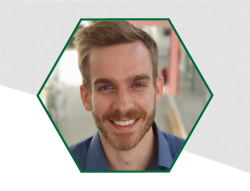Despite the maturity of laser-based powder bed fusion of metals (PBF-LB/M), some barriers prevent the manufacturing process from fully being established in the industry. One drawback is spatter formation, which is disadvantageous to PBF-LB/M for three main reasons. First, adhering spatter can initiate coater collision, resulting in process failure. Second, large adhering spatter may cause lack-of-fusion defects as they require more energy to remelt sufficiently compared to unprocessed powder. Furthermore, big non-adhering spatter cannot be recycled as powder. The recycling of small spatter particles potentially results in degraded material properties. Ring-shaped beam profiles have been established for deep penetration welding to reduce spatter formation. Investigations on ring-shaped beam profiles in PBF-LB/M focus on improving productivity and process robustness. Qualitative spatter reduction in PBF-LB/M using ring-shaped beam profiles has also been reported. This publication quantitatively examines the influence of ring-shaped beam profiles on spatter formation in PBF-LB/M. Image processing algorithms of on-axis high-speed images are utilized for spatter detection and tracking. A self-developed spatter segmentation is used to determine the spatter size. A Laplacian of Gaussian (LoG) filter is combined with a Kalman tracker to count and track the spatter. The results show that spatter formation is highly influenced by the beam profile and the chosen process parameters. Considering the melt track width, ring-shaped beam profiles could reduce the number of spatter per fused area. High numbers of spatter are generated when parameter sets result in balling. Moreover, spatter velocity is primarily dependent on the introduced dimensionless enthalpy.
Keywords
- Additive Manufacturing
- Aisi 316L
- Pbf-Lb/M
- Spatter Formation

